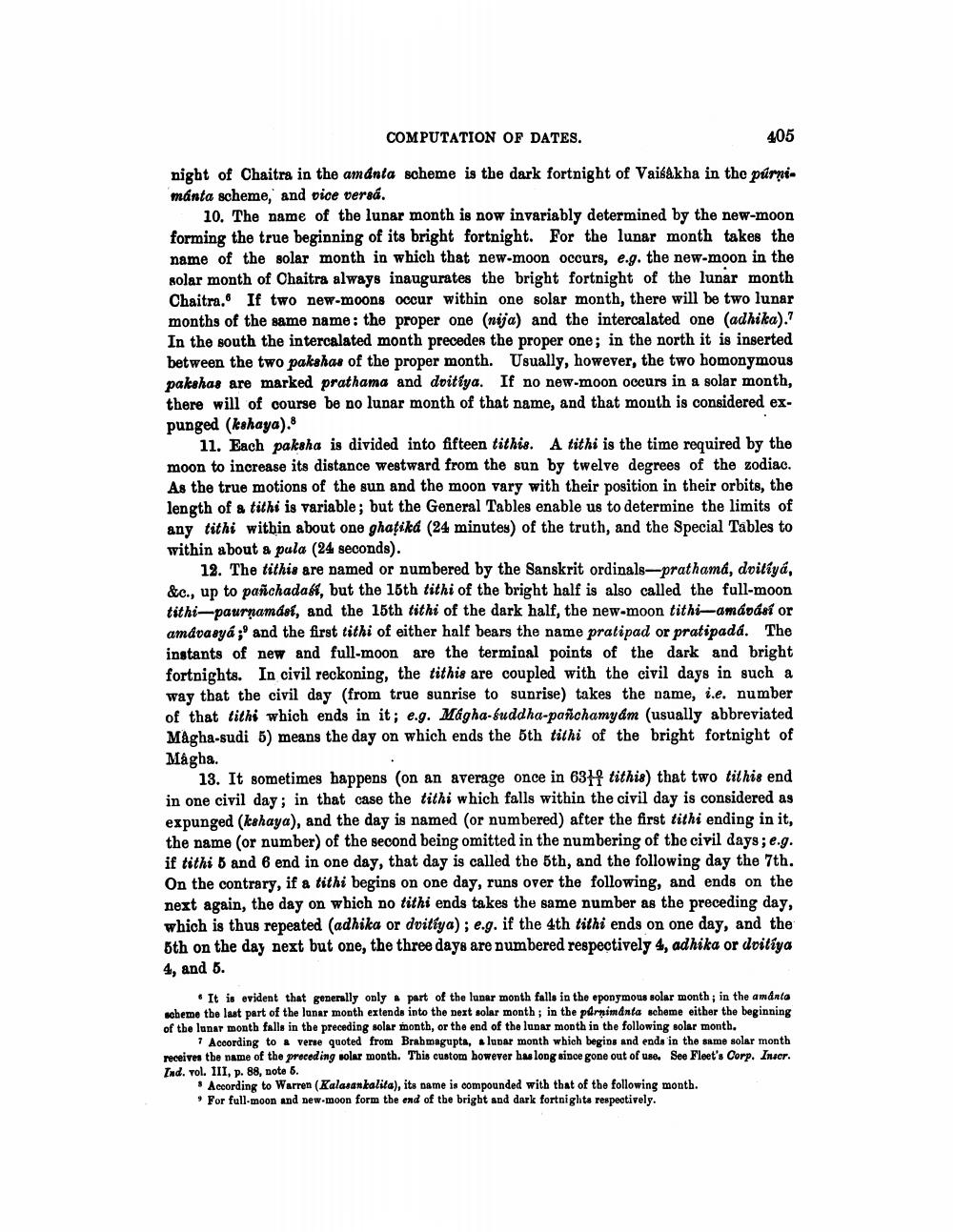________________
COMPUTATION OF DATES.
405
night of Chaitra in the amánta scheme is the dark fortnight of Vaisakha in the púrnimanta scheme,' and vice versa.
10. The name of the lunar month is now invariably determined by the new-moon forming the true beginning of its bright fortnight. For the lunar month takes the name of the solar month in which that new-moon occurs, e.g. the new-moon in the solar month of Chaitra always inaugurates the bright fortnight of the lunar month Chaitra. If two new-moons occur within one solar month, there will be two lunar months of the same name: the proper one (nija) and the intercalated one (adhika).? In the south the intercalated month precedes the proper one; in the north it is inserted between the two pakshas of the proper month. Usually, however, the two homonymous pakshas are marked prathama and doitiya. If no new-moon occurs in a solar month, there will of course be no lunar month of that name, and that month is considered expunged (kshaya).8
11. Each paksha is divided into fifteen tithis. A tithi is the time required by the moon to increase its distance westward from the sun by twelve degrees of the zodiac. As the true motions of the sun and the moon vary with their position in their orbits, the length of a tithi is variable; but the General Tables enable us to determine the limits of any tithi within about one ghagika (24 minutey) of the truth, and the Special Tables to within about a pula (24 seconds).
12. The tithis are named or numbered by the Sanskrit ordinals-prathamá, dvitiya, &c., un to pañchadas, but the 15th tithi of the bright half is also called the full-moon tithi-paurnamásl, and the 15th tithi of the dark half, the new-moon tithi-amádásí or amavasya ;' and the first tithi of either half bears the name pratipad or pratipada. The instants of new and full-moon are the terminal points of the dark and bright fortnights. In civil reckoning, the tithis are coupled with the civil days in such a way that the civil day (from true sunrise to sunrise) takes the name, i.e. number of that tithi which ends in it; e.g. Magha-buddha-panchamyam (usually abbreviated Mågha-sudi 5) means the day on which ends the 5th tithi of the bright fortnight of Magha.
13. It sometimes happens (on an average once in 6311 tithis) that two tithis end in one civil day; in that case the tithi which falls within the civil day is considered as expunged (kahaya), and the day is named (or numbered) after the first tithi ending in it, the name (or number) of the second being omitted in the numbering of the civil days; e.g. if tithi 5 and 6 end in one day, that day is called the 5th, and the following day the 7th. On the contrary, if a tithi begins on one day, runs over the following, and ends on the next again, the day on which no tithi ends takes the same number as the preceding day, which is thus repeated (adhika or dvitiya); e.g. if the 4th tithi ends on one day, and the 6th on the day next but one, the three days are numbered respectively 4, adhika or dvitiya 4, and 6.
• It is evident that generally only part of the lunar month falls in the eponymous solar month; in the amanta scheme the last part of the lunar month extends into the next solar month; in the parnimanta scheme either the beginning of the lunar month falls in the preceding solar month, or the end of the lunar month in the following solar month.
7 According to & verse quoted from Brabmagupta, ludar month which begins and ends in the same solar month receives the name of the preceding solar month. This custom however has long since gone out of use. See Fleet's Corp. Inscr. Ind. vol. III, p. 88, note 6.
• According to Warren (Kalasankalita), its name is compounded with that of the following month. . For full-moon and new moon form the end of the bright and dark fortnights respectively.




